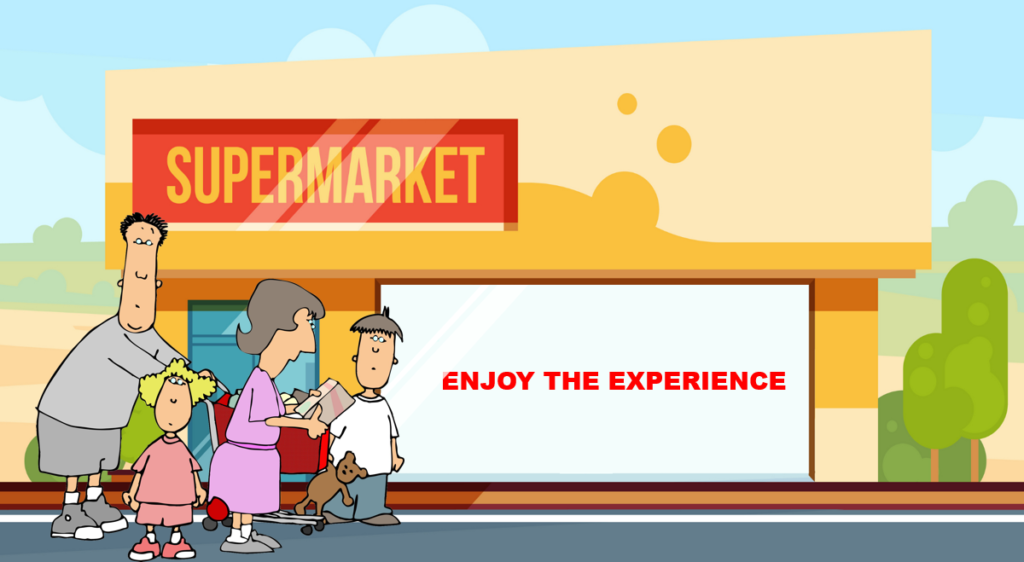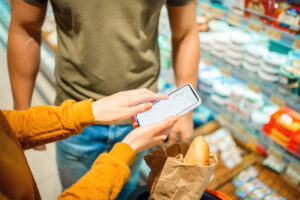For much of early American history, many people grew the plants or raised the livestock they needed to sustain themselves and their families. To obtain food items they couldn’t grow, they visited their local general store where a friendly shopkeeper would dutifully locate requested items from stocked shelves behind the counter. In many ways, the general store was the center of the community — a gathering place where pleasantries were exchanged and local issues could be discussed. Going to the store was an experience.
As people became more urbanized and agriculture became more business-like, the general store turned into the grocery store. Over a century ago, Clarence Saunders opened the first Piggly Wiggly in Memphis, TN. Instead of keeping goods away from customers by storing them on shelves behind counters, Saunders had a different business model in mind. Jerry Cianciolo explains, “The 35-year-old Saunders … reasoned that shoppers would gladly hand-select their own merchandise, and pay upfront, in exchange for lower prices and faster shopping. … King Piggly Wiggly, as Saunders christened his first store, opened Sept. 6, 1916. It stocked 1,000 products, four times the variety of a typical market. Customers entered through a turnstile and, basket in hand, followed a path through the aisles. Goods were neatly arranged with clearly marked prices, something heretofore unseen. There were even scales for shoppers to weigh sugar and other staples.”[1] With that first Piggly Wiggly, grocery shopping became a necessity, but the experience had forever changed.
Can grocery stores once again become an experience destination?
There is a lot of chatter these days about home-delivered meal kits and click-and-collect grocery services. Nevertheless, Pamela N. Danziger (@PamDanziger), a market researcher, reports, “Some 65% of consumers say they have no interest in buying food or beverages online, even when their options improve.”[2] She continues, “While no one disputes that online grocery is a growth market and will take more share away from brick-and-mortar retail, the biggest opportunity today (96-98%) and tomorrow (80%) remains in the physical store. … A new study by Morning Consult reveals that a majority of American consumers are resisting the siren call for online shopping convenience in favor of the in-store shopping experience.” Another interesting result of the survey was that a majority of affluent shoppers (59%) “have no interest in buying food and beverage products online.” This is important, Danziger explains, because “the typical affluent household spends about 75% more on food than average, these are the grocery store shoppers who really matter. They remain loyal to shopping in person.”
To keep these loyal shoppers, Danziger recommends making in-store shopping a true experience. She writes, “Enhancing the in-store shopping experience is the bigger opportunity retailers are overlooking.” Ralph Waldo Emerson once wrote, “Life is a journey, not a destination.” For years, grocery stores and supermarkets have been destinations — places to go when you needed to buy food, but not much more. Mike Eardley (@IDDBAMIKE), President and CEO of the International Dairy Deli Bakery Association (IDDBA), believes supermarkets need to shed their reputation as place to go and become part of life’s journey. He explains, “Purchasing groceries has never been easier for most shoppers, thanks to new channels, both online and physical. … But it doesn’t provide an experience that so many consumers seek out. … Traditional supermarkets have the potential to provide this experience, in a variety of different ways. And it’s not just the larger chains that can capitalize. With a little ingenuity and creativity, any store can develop services and programs that engage shoppers.”[3]
Eardley suggests two ways supermarkets can become more experiential. First, improve in-store dining with innovative food service ideas. “With dining out now more common than cooking from home,” he writes, “a robust prepared food department is becoming a must in supermarkets. … Besides serving as a lunch and dinner destination, a prepared foods program can target the breakfast crowd, a customer demographic growing in importance as more individuals seek out food to start their day away from home.” Implicit in this suggestion is ensuring there are places to sit and enjoy proffered food in an inviting atmosphere. Eardley’s second suggestion is to create a bakery cafe. He explains, “Freshness continues to be one of the most sought-after food attributes. And nothing is fresher than food made right in front of a customer and featuring interesting flavors and ingredients. … These concepts truly embody the spirit of the experience economy, because the smells, sights, and sounds of baked goods being made and displayed in the in-store bakery can truly be a draw to shoppers.”
More and more supermarkets are offering cooking demonstrations encouraging their customers to upgrade their at-home dining experiences. Food magazine editor Jim Dudlicek (@jimdudlicek), reports, “Shopper insights indicate that most consumers still like a brick-and-mortar store experience that delivers sights, sounds and smells, perhaps allowing them to linger over a cup of coffee, a full meal or a cooking demonstration.”[4] Jeffrey Nader, project director at design firm API(+), told Dudlicek, “One of the biggest trends that we are noticing across all retail project types is customer experience. Experience has become the central focus of the design process. Maximizing store layouts with an emphasis on product placement is no longer the focus of the user experience. Instead, the design process has become human-centric, with careful attention to how the public enters and engages with spaces. … A strong focus on quality, freshness, customer service and a unique shopping experience are key elements that are shaping the path for a competitive playground among traditional grocers.”
In-store experiences can even be personalized. Another food magazine editor, David Landsel (@davidlandsel), reports one H-E-B supermarket helped a little boy celebrate his birthday.[5] He writes, “Thomas was turning five, which is kind of a big deal, at least to a four-year-old, and what did he want for his birthday, more than anything? He wanted a trip to the supermarket. … Some supermarkets might have found the request just a little bit bewildering — not H-E-B. The company eagerly agreed to host the event, marking this momentous occasion, at one of their suburban San Antonio stores. Thomas got his own little shopping cart, which ended up full of cool toys. The store mascot — the H-E-Buddy, shaped like a bag stuffed with groceries, came out for hugs, and the whole thing was documented with a gorgeous photo shoot, which everyone immediately began sharing on the Internet.” I daresay Thomas will be a loyal H-E-B shopper for life.
Summary
The modern supermarket will never be as intimate as the general store once was (which isn’t a bad thing considering the limited stock a general store carried); but, it can still provide consumers with experiences they desire. Landsel concludes, “Supermarkets are able to exert this rather unusual hold over us, when done correctly, there are all sorts of little things that can add up — stars, that when aligned, deliver this perfect storm of goodwill to what to many people around the world would be viewed as a relentlessly uninteresting part of life. There is the thrill of a good deal, the calming effect of a good store layout, the feeling of luxury that comes from just the right amount of spaciousness in the aisles (not too much). There are the colors of the produce section, the good lighting in the cold cases, the communal gatherings in the café, chit chat with your neighbors at the coffee bar, the guy who knows your name at the seafood counter, and just how you like things wrapped up. For many of us New Worlders, supermarkets are close to the best we can hope for, in the way of a traditional public square, or a traditional market, two places that have gathered people for centuries. The way we do business may have changed; our desire to gather has not. … Food brings us together, it is where we connect with the people we care about. When a supermarket gets that, the love letters tend to write themselves.”
Footnotes
[1] Jerry Cianciolo, “The Man Who Invented the Grocery Store,” The Wall Street Journal, 7 September 2016.
[2] Pamela N. Danziger, “The Race Is On For Grocery Delivery, But Most Customers Still Want To Shop In Stores,” Forbes, 22 May 2018.
[3] Mike Eardley, “Experiences, Engagement Help Make Stores a Destination,” Winsight Grocery Business, 11 July 2018.
[4] Jim Dudlicek, “Experience is Crucial in the Grocery Store of the Future,” Progressive Grocer, 21 August 2018.
[5] David Landsel, “The Great American Supermarket Is Not Finished With You, Yet,” Food & Wine, 22 August 2018.





